The dry, wind-swept summits of volcanoes in the Puna de Atacama of Chile and Argentina are the closest thing on Earth to the surface of Mars due to their thin atmosphere and freezing temperatures. At their extreme elevations of more than 6,000 meters above sea level, experts had concluded that mammalian life simply wasn’t possible. But researchers reporting October 23 in the journal Current Biology on their discovery of mummified mice in those tough environs now expand the physiologic limits of vertebrate life on Earth.
“The most surprising thing about our discovery is that mammals could be living on the summits of volcanoes in such an inhospitable, Mars-like environment,” says senior author Jay Storz, a biologist at University of Nebraska, Lincoln. “Well-trained mountain climbers can tolerate such extreme elevations during a one-day summit attempt, but the fact that mice are actually living at such elevations demonstrates that we have underestimated the physiological tolerances of small mammals.”
Storz and his colleagues discovered the first mouse mummy on the summit of Volcán Salín by chance when they stumbled across the desiccated cadaver at the edge of a rock pile. But, now knowing what to look for, they soon turned up others.
“Once my climbing partner and I started searching through the rest of the rocks, we found seven more mummies on the same summit,” Storz recalls.
They then started searching systematically on the summits of all the Andean volcanoes. So far, they’ve searched 21 volcano summits, including 18 with elevations over 6,000 meters. All told, they’ve found 13 mummified mice on the summits of multiple volcanoes with an elevation greater than 6,000 meters. In some cases, the mummies were accompanied by skeletal remains of numerous other mice.
Radiocarbon dating showed that the mummified mice found on the summits of two volcanoes were a few decades old at most. Those from a third site were older, estimated at 350 years old at most. Genetic analysis of the summit mummies demonstrated that they represent a species of leaf-eared mouse called Phyllotis vaccarum, which is known to occur at lower elevations in the region.
“The discovery of the mouse mummies on the summits of these freezing, wind-scoured volcano summits was a huge surprise,” Storz says. “In combination with our live-capture records of mice on the summits and flanks of other high elevation Andean volcanoes, we are amassing more and more evidence that there are long-term resident populations of mice living at extreme elevations.”
The finding now raises important questions, including how mammals can live in a barren world of rock, ice, and snow where the temperatures are never above freezing, and there is roughly half the oxygen available at sea level. It’s not clear why the mice would have climbed to such heights. Over 500 years ago, Incas were known to conduct human and animal sacrifices on the summits of some Andean peaks. However, the researchers note that the mummified mice from the volcano summits couldn’t have been transported there by the Incas, given that none are old enough to have co-existed with them.
In ongoing work, the researchers are investigating whether the high-elevation mice have special physiological traits that enable them to survive and function in low-oxygen conditions. They’re conducting physiological experiments on captive mice that were collected from high elevations to find out. They’re also continuing their mountaineering surveys of small mammals on high Andean peaks in Argentina, Bolivia, and Chile.
“With our mountaineering biological surveys in the Andes, we keep making surprising new discoveries about the ecology of extreme high-elevation environments,” Storz says. This work was funded by grants from the National Institutes of Health, the National Science Foundation, the Geographic Society, and FONDECYT.
Current Biology, Storz et al.: “Genomic and radiocarbon insights into the mystery of mouse mummies on the summits of >6000 m Andean volcanoes.” https://www.cell.com/current-biology/fulltext/S0960-9822(23)01161-2


